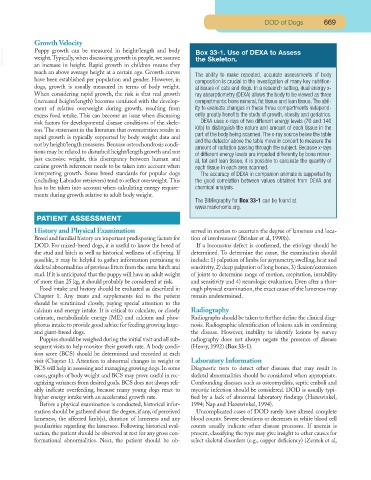Page 646 - Small Animal Clinical Nutrition 5th Edition
P. 646
DOD of Dogs 669
Growth Velocity
VetBooks.ir Puppy growth can be measured in height/length and body Box 33-1. Use of DEXA to Assess
weight.Typically, when discussing growth in people, we assume
the Skeleton.
an increase in height. Rapid growth in children means they
reach an above average height at a certain age. Growth curves
The ability to make repeated, accurate assessments of body
have been established per population and gender. However, in composition is crucial to the investigation of many key nutrition-
dogs, growth is usually measured in terms of body weight. al issues of cats and dogs. In a research setting, dual energy x-
When considering rapid growth, the risk is that real growth ray absorptiometry (DEXA) allows the body to be viewed as three
(increased height/length) becomes confused with the develop- compartments: bone mineral, fat tissue and lean tissue.The abil-
ment of relative overweight during growth, resulting from ity to evaluate changes in these three compartments independ-
excess food intake. This can become an issue when discussing ently greatly benefits the study of growth, obesity and geriatrics.
risk factors for developmental disease conditions of the skele- DEXA uses x-rays of two different energy levels (70 and 140
kVp) to distinguish the nature and amount of each tissue in the
ton.The statement in the literature that overnutrition results in
part of the body being scanned.The x-ray source below the table
rapid growth is typically supported by body weight data and
and the detector above the table move in concert to measure the
not by height/length measures. Because osteochondrosis condi-
amount of radiation passing through the subject. Because x-rays
tions may be related to disturbed height/length growth and not
of different energy levels are impeded differently by bone miner-
just excessive weight, this discrepancy between human and al, fat and lean tissue, it is possible to calculate the quantity of
canine growth references needs to be taken into account when each tissue in each area scanned.
interpreting growth. Some breed standards for popular dogs The accuracy of DEXA in companion animals is supported by
(including Labrador retrievers) tend to reflect overweight.This the good correlation between values obtained from DEXA and
has to be taken into account when calculating energy require- chemical analysis.
ments during growth relative to adult body weight.
The Bibliography for Box 33-1 can be found at
www.markmorris.org.
PATIENT ASSESSMENT
History and Physical Examination served in motion to ascertain the degree of lameness and loca-
Breed and familial history are important predisposing factors for tion of involvement (Brinker et al, 1990b).
DOD. For mixed-breed dogs, it is useful to know the breed of If a locomotor defect is confirmed, the etiology should be
the stud and bitch as well as historical wellness of offspring. If determined. To determine the cause, the examination should
possible, it may be helpful to gather information pertaining to include: 1) palpation of limbs for asymmetry, swelling, heat and
skeletal abnormalities of previous litters from the same bitch and sensitivity, 2) deep palpation of long bones, 3) flexion/extension
stud. If it is anticipated that the puppy will have an adult weight of joints to determine range of motion, crepitation, instability
of more than 25 kg, it should probably be considered at risk. and sensitivity and 4) neurologic evaluation. Even after a thor-
Food intake and history should be evaluated as described in ough physical examination, the exact cause of the lameness may
Chapter 1. Any treats and supplements fed to the patient remain undetermined.
should be scrutinized closely, paying special attention to the
calcium and energy intake. It is critical to calculate, or closely Radiography
estimate, metabolizable energy (ME) and calcium and phos- Radiographs should be taken to further define the clinical diag-
phorus intake to provide good advice for feeding growing large- nosis. Radiographic identification of lesions aids in confirming
and giant-breed dogs. the disease. However, inability to identify lesions by survey
Puppies should be weighed during the initial visit and all sub- radiography does not always negate the presence of disease
sequent visits to help monitor their growth rate. A body condi- (Henry, 1992) (Box 33-1).
tion score (BCS) should be determined and recorded at each
visit (Chapter 1). Attention to abnormal changes in weight or Laboratory Information
BCS will help in assessing and managing growing dogs.In some Diagnostic tests to detect other diseases that may result in
cases, graphs of body weight and BCS may prove useful in rec- skeletal abnormalities should be considered when appropriate.
ognizing variances from desired goals.BCS does not always reli- Confounding diseases such as osteomyelitis, septic emboli and
ably indicate overfeeding, because many young dogs react to mycotic infection should be considered. DOD is usually typi-
higher energy intake with an accelerated growth rate. fied by a lack of abnormal laboratory findings (Hazewinkel,
Before a physical examination is conducted, historical infor- 1994; Nap and Hazewinkel, 1994).
mation should be gathered about the degree, if any, of perceived Uncomplicated cases of DOD rarely have altered complete
lameness, the affected limb(s), duration of lameness and any blood counts. Severe elevations or decreases in white blood cell
peculiarities regarding the lameness. Following historical eval- counts usually indicate other disease processes. If anemia is
uation, the patient should be observed at rest for any gross con- present, classifying the type may give insight to other causes for
formational abnormalities. Next, the patient should be ob- select skeletal disorders (e.g., copper deficiency) (Zentek et al,

